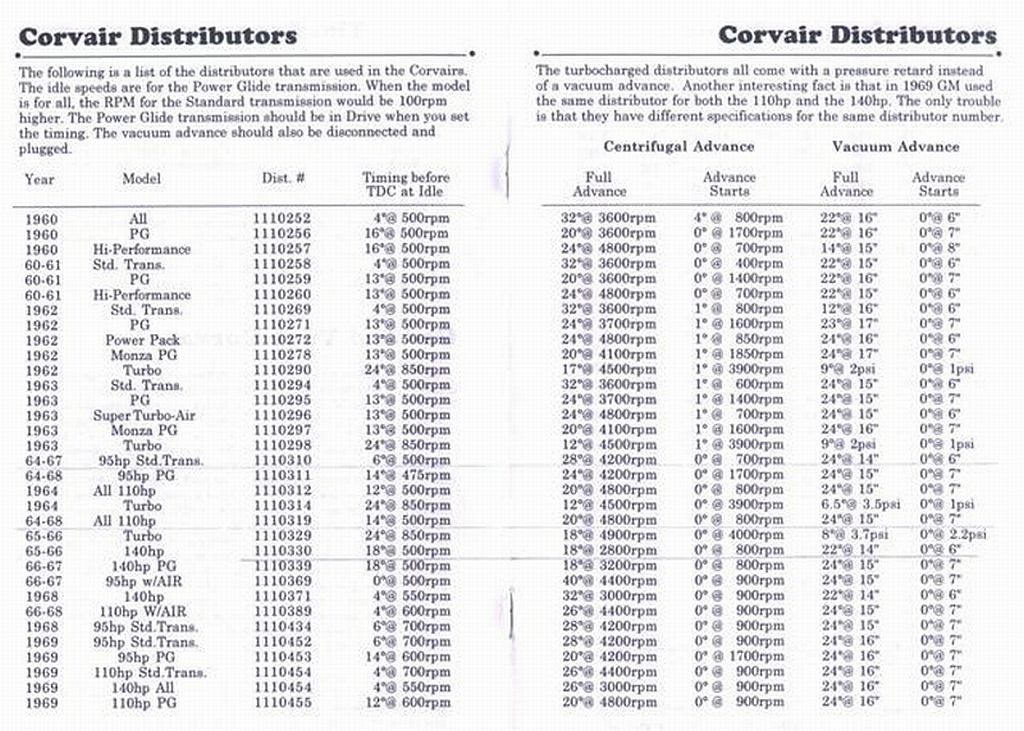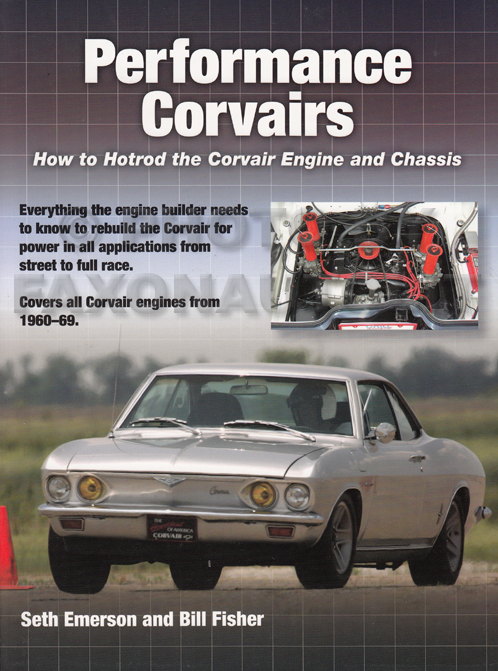Turbo Timing
Turbo Timing
Driving my EM turbo yesterday I could hear slight detonation so I let up. I decided to look at the timing and read in the maintenance manual that it should be at 24 degrees. When I checked my car it was at 12 degrees its running fine I'm just worried about the slight detonation under load. Where should I start it has Pertronix, I run non-ethanol super no other mods.
Thanks!
Thanks!
- bbodie52
- Corvair of the Month

- Posts: 11983
- Joined: Mon Aug 06, 2012 12:33 pm
- Location: Lake Chatuge Hayesville, NC
- Contact:
Re: Turbo Timing
There are many issues involved with a turbocharged Corvair distributor. The initial timing of 24° BTDC may seem excessive, until you include other factors such as a low 8:1 compression ratio, colder spark plugs, a complete lack of a vacuum advance system to provide timing advance at low RPM (off-turbo) engine settings, and limits in the maximum centrifugal advance of only 12°, as opposed to the commonly seen 20° - 24° or more of centrifugal advance seen in normally aspirated engines. In other words, normally aspirated engines start with less timing advance, but dial in more advance via the vacuum advance and centrifugal advance mechanisms. The special turbo distributor provides significantly less advance, so the engine starts out with 24° to help make up for this.
If you read the Bob Helt article below on the pressure retard units, you will discover how unreliable and inaccurate these devices are. A failure in a pressure retard device provides warning to the driver in the form of engine detonation, followed by a melted piston. Unlike modern sensor-based computer-controlled systems, there is no detonation sensor or compensation for increasing ambient air temperatures. The turbo engine is blind to these operational changes, as it happily moves into the "self destruct" operating mode. A completely stock turbo engine with correct timing settings and premium fuel will not necessarily save you. Upgrading to some of the modern ignition control systems available instead of relying on the pressure retard device can help. Otherwise, the best defense may be a well-educated and knowledgeable driver who is constantly aware of the environment and limitations of the turbo Corvair engine and who will operate the car accordingly. (I discovered these limitations at age 18 on a hot day in 1971 while pushing my 1965 turbo Corsa too hard up a long highway upgrade — when I melted a hole in one!)
Left-click the image to enlarge for better viewing...
Click on the link below to read a Bob Helt article on the turbo Corvair pressure retard devices...
 viewtopic.php?f=80&t=10121&p=68881&hili ... ion#p68881
viewtopic.php?f=80&t=10121&p=68881&hili ... ion#p68881
If you don't own a copy of this book, I would strongly suggest that you buy a copy and read it to help you with your Corvair upgrades and improvement investments. I have owned the earlier version of this book since 1970, and bought the updated version when it was published last year. It is filled with a great deal of informative material that has been developed and collected over decades of Corvair ownership and racing. At $21.72 it is a good Corvair "bible" that will help you to make educated, informed decisions for your Corvair before you actually spend time and money.
 http://www.amazon.com/Performance-Corva ... th+emerson
http://www.amazon.com/Performance-Corva ... th+emerson


If you read the Bob Helt article below on the pressure retard units, you will discover how unreliable and inaccurate these devices are. A failure in a pressure retard device provides warning to the driver in the form of engine detonation, followed by a melted piston. Unlike modern sensor-based computer-controlled systems, there is no detonation sensor or compensation for increasing ambient air temperatures. The turbo engine is blind to these operational changes, as it happily moves into the "self destruct" operating mode. A completely stock turbo engine with correct timing settings and premium fuel will not necessarily save you. Upgrading to some of the modern ignition control systems available instead of relying on the pressure retard device can help. Otherwise, the best defense may be a well-educated and knowledgeable driver who is constantly aware of the environment and limitations of the turbo Corvair engine and who will operate the car accordingly. (I discovered these limitations at age 18 on a hot day in 1971 while pushing my 1965 turbo Corsa too hard up a long highway upgrade — when I melted a hole in one!)
Left-click the image to enlarge for better viewing...

Click on the link below to read a Bob Helt article on the turbo Corvair pressure retard devices...
If you don't own a copy of this book, I would strongly suggest that you buy a copy and read it to help you with your Corvair upgrades and improvement investments. I have owned the earlier version of this book since 1970, and bought the updated version when it was published last year. It is filled with a great deal of informative material that has been developed and collected over decades of Corvair ownership and racing. At $21.72 it is a good Corvair "bible" that will help you to make educated, informed decisions for your Corvair before you actually spend time and money.


Brad Bodie
Lake Chatuge, North Carolina
 1966 Corvair Corsa Convertible
1966 Corvair Corsa Convertible
Lake Chatuge, North Carolina
 1966 Corvair Corsa Convertible
1966 Corvair Corsa ConvertibleRe: Turbo Timing
Your best investment on a Turbo is a Safeguard ignition system from American Pi. Looks almost stock.
That said yes 24 degrees timing, premium fuel, make sure your pressure retard can is working.
That said yes 24 degrees timing, premium fuel, make sure your pressure retard can is working.
Nick
1964 Monza Spyder Convertible #435 - Rotisserie restored - SOLD ON BRING A TRAILER 4/30/2019 - Check out my restoration thread here: [corvaircenter.com]
Thanks to all the awesome CCF, CF, COG, and CORSA members who helped me with the restoration!
1964 Monza Spyder Convertible #435 - Rotisserie restored - SOLD ON BRING A TRAILER 4/30/2019 - Check out my restoration thread here: [corvaircenter.com]
Thanks to all the awesome CCF, CF, COG, and CORSA members who helped me with the restoration!
- bbodie52
- Corvair of the Month

- Posts: 11983
- Joined: Mon Aug 06, 2012 12:33 pm
- Location: Lake Chatuge Hayesville, NC
- Contact:
Re: Turbo Timing
Brad Bodie
Lake Chatuge, North Carolina
 1966 Corvair Corsa Convertible
1966 Corvair Corsa Convertible
Lake Chatuge, North Carolina
 1966 Corvair Corsa Convertible
1966 Corvair Corsa ConvertibleRe: Turbo Timing
What's the part number of your distributor? The correct turbo one sometimes gets replaced by a vacuum advance distributor on accident (people don't know the difference), if that happened it will never run right no matter what you set base timing to. Your boost retard (if you do have the correct distributor) is broken, don't bother testing it. Ask me how I know, I won't trust one no matter how far I throw it. Your only recourse is a programmable ignition like the ones mentioned already, but I will add my picks:
I put EDIS/Megajolt on my Corvair, and haven't looked back since. It's a coil pack ignition so you either have to get the American Pi distributor shaft/plug arrangement, or just leave the distributor in there looking all lost and stuff. I built my own jackshaft to run the oil pump, but I have lathe access. EDIS will give you trouble free ignition with timing maps for idle/full throttle/boost in high resolution, with more accuracy than anything distributor based.
Second choice would be the Black Box from CB Performance out in Farmersville, CA. Works with the stock distributor, but gives you timing map control just like EDIS does. Best bang-for-buck mod out there, in my book.
I suppose the phantom third option would be limiting your stock turbo distributor's advance and doing away with the retard can, but the engine won't like it on the freeway and your MPG will likely drop to single digits.
YMMV.
I put EDIS/Megajolt on my Corvair, and haven't looked back since. It's a coil pack ignition so you either have to get the American Pi distributor shaft/plug arrangement, or just leave the distributor in there looking all lost and stuff. I built my own jackshaft to run the oil pump, but I have lathe access. EDIS will give you trouble free ignition with timing maps for idle/full throttle/boost in high resolution, with more accuracy than anything distributor based.
Second choice would be the Black Box from CB Performance out in Farmersville, CA. Works with the stock distributor, but gives you timing map control just like EDIS does. Best bang-for-buck mod out there, in my book.
I suppose the phantom third option would be limiting your stock turbo distributor's advance and doing away with the retard can, but the engine won't like it on the freeway and your MPG will likely drop to single digits.
YMMV.
Re: Turbo Timing
Thank you all for the information, I checked my distributor and the number is Delco Remy 1110290 2E5 according to the chart it's the right one any ideas why the timing is set to 12 degrees? The pressure retard has the correct turbo nipple how do I test the pressure retard unit? If I putt around town out of boost range is that ok until I upgrade or am I gambling with a melt down. I would like to stay as stock looking as possible here she is:
Re: Turbo Timing
I forgot to add that it has Pertronix and the idle is at 750 rpm.
Re: Turbo Timing
Doing a little more reasearch and found that a Clarks pressure retard unit requires 18 degrees I'll look at my set up again tomorrow bump it up a little and report back.
Thanks for all the help
Thanks for all the help
- PressurizedPancake
- Posts: 19
- Joined: Mon Jan 06, 2014 6:21 pm
- Location: Phoenix, AZ
Re: Turbo Timing
After reading about all of the slipped stock harmonic balancers on various Corvair sites, I think the place I'd start would be to verify that your TDC mark on your flywheel really still does represent TDC. Once that is verified, then you can continue the diagnostics/improvement path you choose with faith in your results. I believe it's always good to know ground zero and build from there. If for some reason it has slipped, that is the first thing to rectify before changing other parts.737ETOPS wrote:Where should I start it has Pertronix, I run non-ethanol super no other mods.
Thanks!
Good luck! And great looking car, by the way.
You're unique, just like everyone else.
- bbodie52
- Corvair of the Month

- Posts: 11983
- Joined: Mon Aug 06, 2012 12:33 pm
- Location: Lake Chatuge Hayesville, NC
- Contact:
Re: Turbo Timing
PressurizedPancake wrote:After reading about all of the slipped stock harmonic balancers on various Corvair sites, I think the place I'd start would be to verify that your TDC mark on your flywheel really still does represent TDC. Once that is verified, then you can continue the diagnostics/improvement path you choose with faith in your results. I believe it's always good to know ground zero and build from there. If for some reason it has slipped, that is the first thing to rectify before changing other parts.
I considered a harmonic balancer issue, but when I looked back at previous posts I found that his car is a 1962 Spyder, and would not have a harmonic balancer installed on the engine unless an engine replacement has been done with a 1964 or later engine.

According to the distributor chart, the 1962 distributor was programmed to provide a full 17° of centrifugal timing advance, while the 1963 distributor was changed to restrict centrifugal timing advance to only 12°. Also, in turbocharged engines the timing advance does not begin until approximately 3900 RPM. In normally-aspirated Corvair engines the centrifugal advance starts having an effect at a much-lower RPM, and vacuum advance is also dialed in with normally-aspirated engines. Turbocharged engines have no vacuum advance at all, but the turbo engine is supposed to see 8-9º of TIMING RETARD under boost. Since the turbocharger and compression ratio did not change between 1962 and 1963, the only explanation for the distributor timing curve change in 1963 might be a camshaft grind change that was implemented in the 1963 turbocharged engine. In 1962 the turbocharged engine was using the same camshaft as the 102 hp engine, and in 1964 the turbocharged engine reverted back to the same camshaft that was used in the 110 hp engine.
- 1962 Turbo Centrifugal Advance: 17° @ 4500 RPM
- 1963 Turbo Centrifugal Advance: 12° @ 4500 RPM
- 1964 Turbo Centrifugal Advance: 12° @ 4500 RPM
- 1965 Turbo Centrifugal Advance: 18° @ 4900 RPM
- 1966 Turbo Centrifugal Advance: 18° @ 4900 RPM
CONTROLLING VACUUM ADVANCE:
Let’s look at how the vacuum advance system is controlled. Referring back again to burn rates, remember that lean mixtures burn slower and rich mixtures burn faster. Engine load conditions (idle, steady cruise, acceleration) result in how lean or rich the air/fuel mixture is (the carburetor handles this), and the best indicator of engine load is intake manifold vacuum. At idle and steady cruise, engine load is low, and intake manifold vacuum is high due to the nearly closed carburetor throttle plates. Under acceleration, the throttle plates open wider, and intake manifold vacuum drops. It is essentially zero at wide-open throttle. As a result, intake manifold vacuum is a “free” indicator of engine load, which correlates nicely with fuel mixture being supplied – lean mixture at high vacuum, and rich mixture at low vacuum.
At idle, the engine needs additional spark advance in order to fire the lean (and exhaust-diluted) idle fuel/air mixture earlier in the cycle in order to develop maximum cylinder pressure at the proper point after TDC for efficiency, so the vacuum advance unit is activated by the high manifold vacuum, and adds another 15 degrees of spark advance on top of the fixed initial timing setting. For example, if your initial timing is set at 10 degrees, at idle it’s actually 25 degrees with the vacuum advance connected (a properly calibrated centrifugal advance mechanism will not have started to move yet at idle rpm).
The same thing occurs under steady highway cruise conditions. The mixture is lean, takes longer to burn, the load on the engine is low (it takes only about 40 horsepower to cruise at 50mph) and the manifold vacuum is high, so the vacuum advance unit is again deployed and adds 15 degrees of spark advance over and above whatever the distributor centrifugal advance mechanism is providing at that engine rpm. If you had a timing light connected so you could see it as you cruise down the highway, you’d see about 45-50 degrees of spark advance – your fixed initial advance of 10 degrees, 20-25 degrees provided by the centrifugal advance mechanism, and the 15 degrees added by the vacuum advance unit.
When you accelerate, the fuel/air mixture is immediately enriched (by the accelerator pump, power valve, metering rod piston, etc.), and that rich mixture now burns faster and doesn’t need the additional spark advance anymore. When the throttle plates open, the manifold vacuum drops, and the vacuum advance unit diaphragm retracts to its zero position, “retarding” the spark timing back to what is being provided at that moment by the fixed initial timing and the centrifugal advance mechanism. The vacuum advance doesn’t come back into play until you back off the gas and manifold vacuum increases again as you return to steady-state cruise, when the mixture again becomes lean and needs more spark advance for fuel efficiency.
- Attachments
-
- Timing, Vacuum Advance, and Centrifugal Advance.pdf
- Timing, Vacuum Advance, and Centrifugal Advance
- (2.09 MiB) Downloaded 43 times
Brad Bodie
Lake Chatuge, North Carolina
 1966 Corvair Corsa Convertible
1966 Corvair Corsa Convertible
Lake Chatuge, North Carolina
 1966 Corvair Corsa Convertible
1966 Corvair Corsa ConvertibleRe: Turbo Timing
Amazing amount of information thanks guys.



